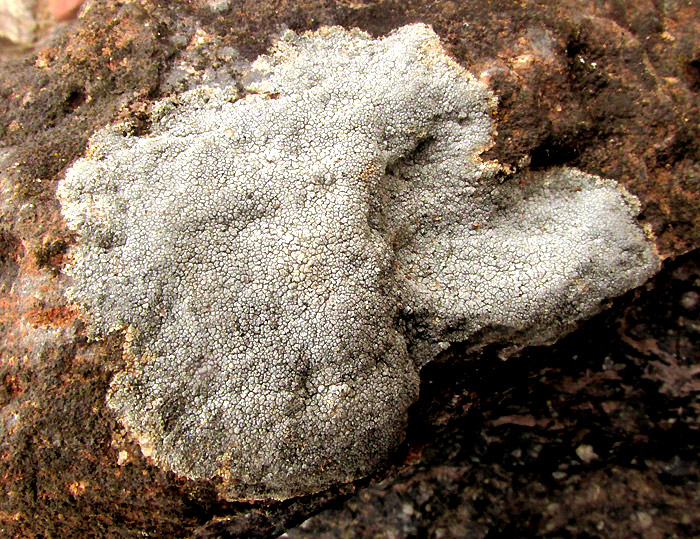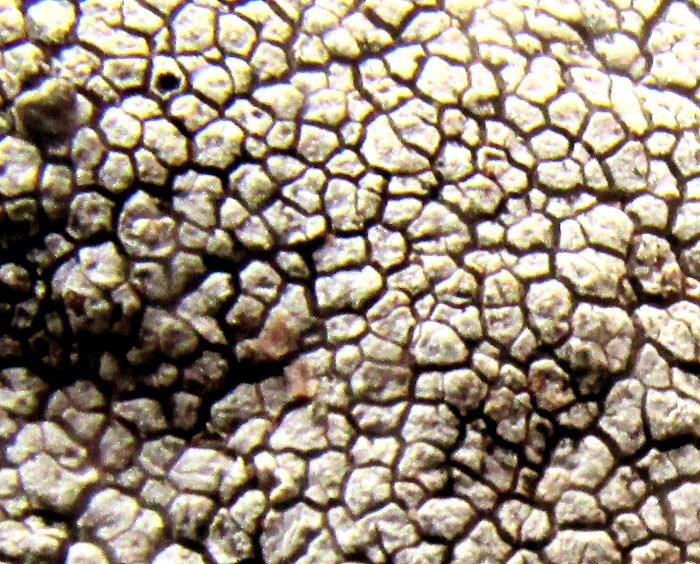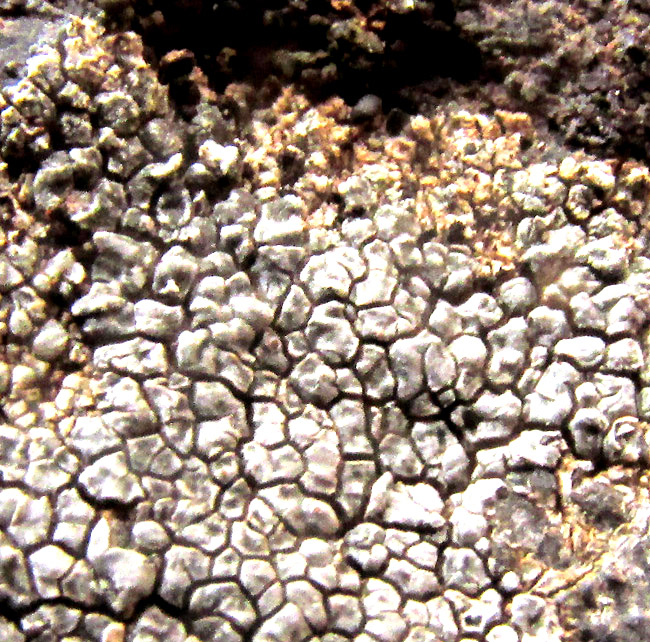Excerpts from Jim Conrad's
Naturalist Newsletter
Entry dated December 16, 2023, issued from near Tequisquiapan; elevation about 1,900m, (6200 ft), ~N20.57°, ~W99.89°; Querétaro state, MÉXICO
CINDER LICHEN

The above hand-size crustose lichen on a knee-high rock composed of black, volcanic basalt caught my eye because from a distance it looked unusually smooth, with a bluish tint.

Above, the striking feature is that the lichen's body, or thallus, is fissured throughout into angular, flat-topped sections referred to as areoles. A few areole tops were sunken in their centers, and some had developed black-bottom pits, as seen in the above picture's top, left corner. That's a developing apothecium, the reproductive body which later will release sexually produced spores, for reproduction. Probably the other areoles with slightly depressed tops are in the early stages of apothecium creation.

At the lichen's margins, areoles became smaller, less regularly formed, and often the fringe area acquired a slightly reddish-orange color. For this species, LichenPortal.org reports spot tests of "P+ orange" and K+ red," meaning that if place a drop of bleach on it, it turns orange, while a drop of potassium hydroxide, KOH, makes it red. Both bleach and potassium hydroxide are strong bases, the opposite of being acidic. This species usually occurs on silicon-rich, metamorphic or volcanic rocks, such as basalt, which which are regarded as acidic substrates.
My guess is that the lichen's margins are turning orange because during the preceding months no rain occurred and dust composed largely of basic limestone gathered on the rock. During a recent rain, the dust formed a weak basic solution, causing the color change at the margin. The surrounding altiplano flatlands from which the dust would have been derived are composed of sediment from the nearby Eastern Sierra Madre Mountains, which mostly are made of limestone, which tests basic.
We've met a very similar lichen, the Calcareous Rimmed Lichen, on a similar-sized limestone rock. That species, belonging to the genus Aspicilia, seemed less likely to form such distinct and similarly sized areoles, exhibited no faintly blue hue, and definitely favored basic-testing limestone rock.
Based on records of Aspicilia species documented from upland central Mexico, our basalt-rock lichen best matches pictures of ASPICILIA CINEREA, the Cinder Lichen.
Cinder Lichens commonly occur in Eurasia and North America, and spottily elsewhere worldwide. Mexico's highlands constitute a southward-reaching biological peninsula of northern temperate climates, so there's little to keep wind-transported lichen spores from finding congenial accommodations here.
LichenPortal.org's page for Aspicilia cinerea reports that the photosynthesizing organism entangled with the lichen's fungal hyphae is "chlorococcoid," referring to green algae cells with a spherical shape.
Finding lichen species mainly documented from places like Scandinavia, one wonders whether we might have a look-alike species not yet recognized by science. However, lichens in central Mexico haven't been well studied, so currently there's just no answer to that question.
Also, with taxonomy in such an uproar about species evolving in unforeseen ways -- with horizontal gene transfer, convergent evolution, cryptic species, the fact that lichens are composed of two or more species to begin with -- the best we can do here is to file this page on the Internet under a reasonable name. Any researcher taking a comprehensive and critical look at lichens in this part of the world now will see that here we have a lichen with the appearance documented on this page.